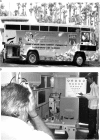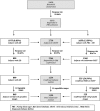Prevalence and risk factors for diabetic retinopathy in rural India. Sankara Nethralaya Diabetic Retinopathy Epidemiology and Molecular Genetic Study III (SN-DREAMS III), report no 2
- PMID: 25452856
- PMCID: PMC4212556
- DOI: 10.1136/bmjdrc-2013-000005
Prevalence and risk factors for diabetic retinopathy in rural India. Sankara Nethralaya Diabetic Retinopathy Epidemiology and Molecular Genetic Study III (SN-DREAMS III), report no 2
Abstract
Objective: The study was aimed at estimating the prevalence of type 2 diabetes mellitus and diabetic retinopathy in a rural population of South India.
Design: A population-based cross-sectional study.
Participants: 13 079 participants were enumerated.
Methods: A multistage cluster sampling method was used. All eligible participants underwent comprehensive eye examination. The fundi of all patients were photographed using 45°, four-field stereoscopic digital photography, and an additional 30° seven-field stereo digital pairs were taken for participants with diabetic retinopathy. The diagnosis of diabetic retinopathy was based on Klein's classification.
Main outcome measures: Prevalence of diabetes mellitus and diabetic retinopathy and associated risk factors.
Results: The prevalence of diabetes in the rural Indian population was 10.4% (95% CI 10.39% to 10.42%); the prevalence of diabetic retinopathy, among patients with diabetes mellitus, was 10.3% (95% CI 8.53% to 11.97%). Statistically significant variables, on multivariate analysis, associated with increased risk of diabetic retinopathy were: gender (men at greater risk; OR 1.52; 95% CI 1.01 to 2.29), use of insulin (OR 3.59; 95% CI 1.41 to 9.14), longer duration of diabetes (15 years; OR 6.01; 95% CI 2.63 to 13.75), systolic hypertension (OR 2.14; 95% CI 1.20 to 3.82), and participants with poor glycemic control (OR 3.37; 95% CI 2.13 to 5.34).
Conclusions: Nearly 1 of 10 individuals in rural South India, above the age of 40 years, showed evidence of type 2 diabetes mellitus. Likewise, among participants with diabetes, the prevalence of diabetic retinopathy was around 10%; the strongest predictor being the duration of diabetes.
Keywords: Incidence; Retinopathy.
Figures
References
-
- Anjana RM, Pradeepa R, Deepa M, ICMR–INDIAB Collaborative Study Group et al. . . Prevalence of diabetes and prediabetes (impaired fasting glucose and/or impaired glucose tolerance) in urban and rural India: phase I results of the Indian Council of Medical Research-INdia DIABetes (ICMR-INDIAB) study. Diabetologia 2011;54:3022–7 - PubMed
-
- Ramachandran A, Snehalatha C, Ma RC. Diabetes in South-East Asia: an update for 2013 for the IDF Diabetes Atlas. Diabetes Res Clin Pract 2014;103:231–7 - PubMed
-
- IDF Diabetes Atlas, 2013; sixth edition, 34.
-
- Mohan V, Deepa M, Deepa R, et al. . Secular trends in the prevalence of diabetes and impaired glucose tolerance in urban South India-the Chennai Urban Rural Epidemiology Study (CURES-17). Diabetologia 2006;49:1175–8 - PubMed
-
- Rajiv R, Rani PK, Sudhir R, et al. . Prevalence of diabetic retinopathy in India Sankara Nethralaya Diabetic Retinopathy Epidemiology and Molecular Genetics Study report 2. Ophthalmology 2009;116:311–18 - PubMed
LinkOut - more resources
Full Text Sources
Other Literature Sources



